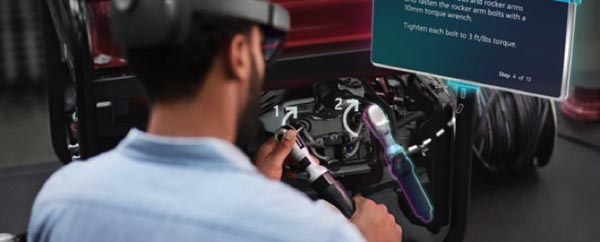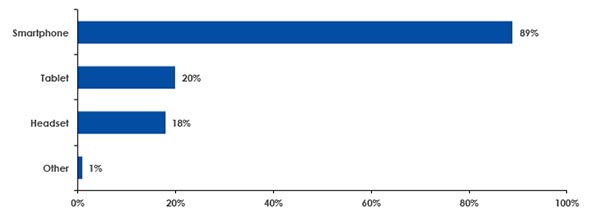- The new headset doubles the previous Hololens’ field of view (FOV) capability, promising a viewscreen of at least 60 degrees.
- For a larger-scale production printers, employees using the Hololens 2 will be able to spot potential hardware problems quicker and make repairs faster, even if the work is specialized.
- At $3,500 per headset, the Hololens 2 carries a price tag that is well outside what the typical consumer will be interested in paying for MR.
By Colin McMahon
Introduction
Last month at MWC Barcelona, Microsoft made headlines when it unveiled its Hololens 2 mixed reality (MR) headset. The device, which will replace the first Hololens as the premier Microsoft headset, looks to improve upon virtually every vital aspect of the previous hardware. It also includes several new innovations that will help open up new software, app, and use possibilities.
While several industry verticals have already embraced MR and its potential for both internal and external applications, print service providers (PSPs) may wonder if this new hardware is worth their time, and exactly how large of an impact it will have on the print market as a whole. Although Hololens 2 represents an improvement in MR technology and a step forward, this is still an enterprise-focused device that is not expected to have a large impact on the consumer space at this time.
How Hololens 2 Can Help PSPs
Microsoft has made it clear that businesses are the primary audience for its Hololens 2. The new headset doubles the previous Hololens’ field of view (FOV) capability, promising a viewscreen of at least 60 degrees. This will enable workers who are using the Hololens 2 to better maintain their focus because they will no longer need to look off to a boxed corner of their vision. Hololens 2 also features eye-tracking, meaning that it will follow the user’s vision and respond exactly to what he or she is looking at. Like the previous version, the Hololens 2 uses a hand gesture-based interface. Unlike its predecessor, however, the new Hololens has an AI-empowered time-of-flight depth sensor. This means that it is much better at tracking motion in real time, which should improve the user’s ability to interact with projected holograms and make for a more seamless work environment.
While all of this sounds—and is—impressive, PSPs might still be scratching their heads and wondering what Microsoft’s latest headset could mean for them. In a nutshell, these improvements make the Hololens 2 a more useful device on the factory floor. For a larger-scale production printers, employees using the Hololens 2 will be able to spot potential hardware problems quicker and make repairs faster, even if the work is specialized.
Hololens 2 is a useful tool for PSPs that are seeking to improve their operational efficiency. Featuring a new interface that enables and empowers multitasking, the headset can create a workforce that makes it possible to respond more quickly to situations as they are developing. The Hololens 2 can also help a company ensure that all staff members are trained on specialized printer hardware without investing money and time into comprehensive educational initiatives.
Hololens 2 Guided Application Training

Source: IT Business
What About the Consumer Market?
While Hololens 2 will certainly impact the professional space, Keypoint Intelligence – InfoTrends does not expect the device to make significant inroads into the consumer market. Part of this is because of the cost—at $3,500 per headset, the Hololens 2 carries a price tag that is well outside what the typical consumer will be interested in paying for MR. In addition, consumer MR faces several other barriers, including a lack of widely available 5G Internet as well as privacy concerns. Many consumers are still uncomfortable with the idea of strapping an always-connected device to their heads. At this time, individuals who are interested in using mixed or augmented reality for their print applications are better off sticking with mobile-based technologies. According to InfoTrends’ 2018 Immersive Imaging Study, most U.S. consumers used smartphones for MR applications. Only 18% used a headset.
Which of the following devices have you used for MR/AR applications (multiple responses permitted)?

N = 1,011 Respondents who have tried AR
Source: U.S. Immersive Imaging Study; Keypoint Intelligence – InfoTrends 2018
That said, the Hololens 2 represents a continuing advancement for MR headset hardware. While this and other top-line devices like Magic Leap are not expected to have a major impact on the commercial space, they offer evidence that a future device someday might. The Hololens 2 represents a vast improvement over its predecessor. If Microsoft continues to invest in this type of technology, it is not unreasonable to say that the company might be ready with a mass-market device by 2022.
The Bottom Line
Many PSPs are implementing modernization strategies to boost sales while reducing operational costs. They are also, in some cases, combatting a narrative that print is an outdated technology in today’s digital world. MR is a technology that helps unify the digital and the physical, creating an enhanced landscape that remains in its infancy.
For big production print companies, using a headset like the Hololens 2 on the ground floor can help minimize the downtime in machine breaks, while also creating a greater and more ubiquitous level of hardware education among their staff members. At the same time, however, those who might envision using the Hololens 2 as a new platform for print-based AR applications should proceed with caution. Microsoft’s newest headset is designed for enterprises and not consumers, so all investments should be made with that in mind.
Colin McMahon is a Research Analyst at Keypoint Intelligence – InfoTrends. He primarily supports the Business Development Strategies and Customer Communications services. In this role, he creates and refines much of InfoTrends’ written content, including forecasts, industry analysis, and research/multi-client studies. He also assists with the editing and formatting processes for many types of deliverables.















Discussion
Join the discussion Sign In or Become a Member, doing so is simple and free